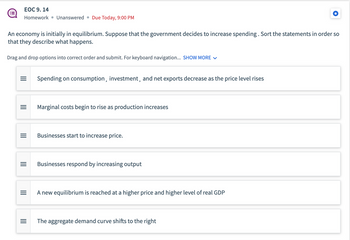
ENGR.ECONOMIC ANALYSIS
14th Edition
ISBN: 9780190931919
Author: NEWNAN
Publisher: Oxford University Press
expand_more
expand_more
format_list_bulleted
Question
How do I rearrange this in order?

Transcribed Image Text:EOC 9. 14
Homework Unanswered Due Today, 9:00 PM
An economy is initially in equilibrium. Suppose that the government decides to increase spending. Sort the statements in order so
that they describe what happens.
Drag and drop options into correct order and submit. For keyboard navigation... SHOW MORE ✓
= Spending on consumption, investment, and net exports decrease as the price level rises
III
|||
=
|||
|||
Marginal costs begin to rise as production increases
Businesses start to increase price.
Businesses respond by increasing output
A new equilibrium is reached at a higher price and higher level of real GDP
The aggregate demand curve shifts to the right
Expert Solution
arrow_forward
Introduction
The aggregate demand/supply model demonstrates how total supply and total demand interact at the macroeconomic level as well as what factors affect total supply or total demand for the economy. Consumption spending, investment spending, government spending, and spending on exports minus imports make up the four parts that make up aggregate demand. Raising any of these factors causes the AD curve to move to the right, which boosts real GDP and puts pressure on the price level to rise. Every component decrease causes the AD curve to move to the left, lowering the price level and real GDP as a result. Consumers typically spend more when they are more optimistic about the direction of the economy. Businesses choose to spend more on investments when there is a high level of business confidence since they think the return on their investment will be significant in the future. In contrast, when consumer or corporate confidence wanes, expenditure on consumption and investments falls.
Trending nowThis is a popular solution!
Step by stepSolved in 2 steps

Knowledge Booster
Learn more about
Need a deep-dive on the concept behind this application? Look no further. Learn more about this topic, economics and related others by exploring similar questions and additional content below.Similar questions
- what is customer satisfaction for food ?arrow_forwardWhy do some frozen pizzas cost more than others? Think generic versus name brand. Why would a customer opt to purchase a name brand pizza over a generic brand?arrow_forwardWhat happens in the market for beach towels,now that the season is over? Graph and explainarrow_forward
Recommended textbooks for you

 Principles of Economics (12th Edition)EconomicsISBN:9780134078779Author:Karl E. Case, Ray C. Fair, Sharon E. OsterPublisher:PEARSON
Principles of Economics (12th Edition)EconomicsISBN:9780134078779Author:Karl E. Case, Ray C. Fair, Sharon E. OsterPublisher:PEARSON Engineering Economy (17th Edition)EconomicsISBN:9780134870069Author:William G. Sullivan, Elin M. Wicks, C. Patrick KoellingPublisher:PEARSON
Engineering Economy (17th Edition)EconomicsISBN:9780134870069Author:William G. Sullivan, Elin M. Wicks, C. Patrick KoellingPublisher:PEARSON Principles of Economics (MindTap Course List)EconomicsISBN:9781305585126Author:N. Gregory MankiwPublisher:Cengage Learning
Principles of Economics (MindTap Course List)EconomicsISBN:9781305585126Author:N. Gregory MankiwPublisher:Cengage Learning Managerial Economics: A Problem Solving ApproachEconomicsISBN:9781337106665Author:Luke M. Froeb, Brian T. McCann, Michael R. Ward, Mike ShorPublisher:Cengage Learning
Managerial Economics: A Problem Solving ApproachEconomicsISBN:9781337106665Author:Luke M. Froeb, Brian T. McCann, Michael R. Ward, Mike ShorPublisher:Cengage Learning Managerial Economics & Business Strategy (Mcgraw-...EconomicsISBN:9781259290619Author:Michael Baye, Jeff PrincePublisher:McGraw-Hill Education
Managerial Economics & Business Strategy (Mcgraw-...EconomicsISBN:9781259290619Author:Michael Baye, Jeff PrincePublisher:McGraw-Hill Education


Principles of Economics (12th Edition)
Economics
ISBN:9780134078779
Author:Karl E. Case, Ray C. Fair, Sharon E. Oster
Publisher:PEARSON

Engineering Economy (17th Edition)
Economics
ISBN:9780134870069
Author:William G. Sullivan, Elin M. Wicks, C. Patrick Koelling
Publisher:PEARSON

Principles of Economics (MindTap Course List)
Economics
ISBN:9781305585126
Author:N. Gregory Mankiw
Publisher:Cengage Learning

Managerial Economics: A Problem Solving Approach
Economics
ISBN:9781337106665
Author:Luke M. Froeb, Brian T. McCann, Michael R. Ward, Mike Shor
Publisher:Cengage Learning

Managerial Economics & Business Strategy (Mcgraw-...
Economics
ISBN:9781259290619
Author:Michael Baye, Jeff Prince
Publisher:McGraw-Hill Education